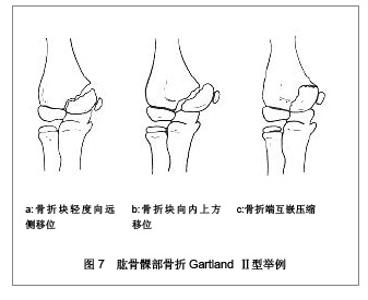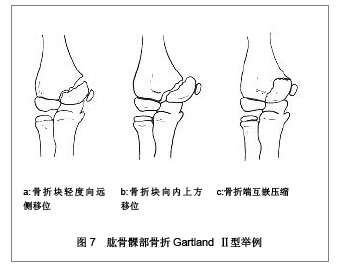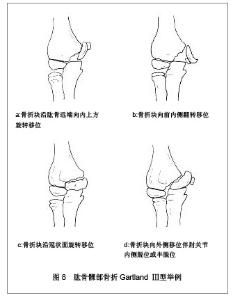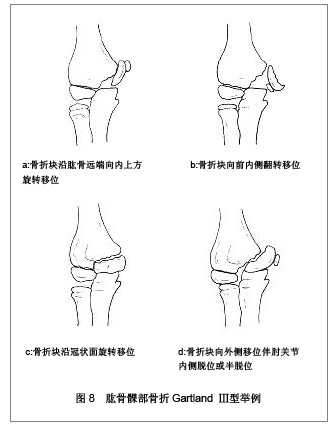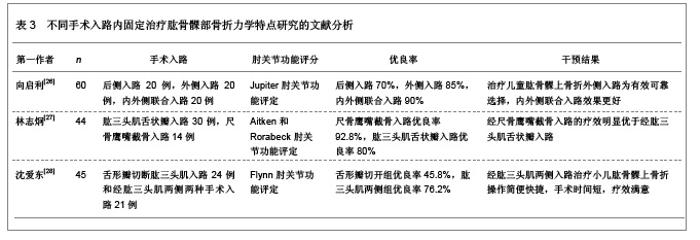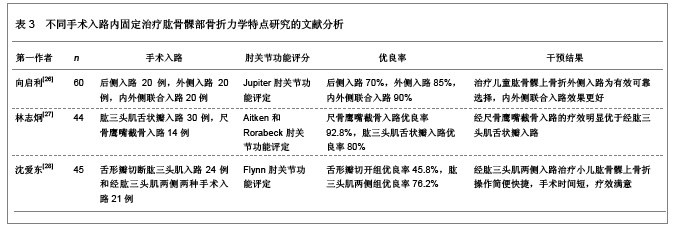Chinese Journal of Tissue Engineering Research ›› 2013, Vol. 17 ›› Issue (4): 704-711.doi: 10.3969/j.issn.2095-4344.2013.04.022
Previous Articles Next Articles
Mechanical analysis of metal implants for the treatment of humeral condylar fractures
Yang Jia-de, Chen Gui-rong, Zhang You-wen
- Department of Trauma Surgery, Dayao People’s Hospital, Chuxiong Yi Autonomous Prefecture 675000, Yunnan Province, China
-
Received:2012-11-02Revised:2013-01-05Online:2013-01-22Published:2013-01-22 -
About author:Yang Jia-de, Attending physician, Department of Trauma Surgery, Dayao People’s Hospital, Chuxiong Yi Autonomous Prefecture 67500, Yunnan Province, China Dailin640625@163.com
CLC Number:
Cite this article
Yang Jia-de, Chen Gui-rong, Zhang You-wen. Mechanical analysis of metal implants for the treatment of humeral condylar fractures[J]. Chinese Journal of Tissue Engineering Research, 2013, 17(4): 704-711.
share this article
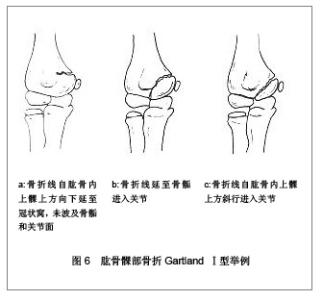
1 肱骨髁部骨折的力学特点 1.1 肱骨髁部骨折Gartland 分型 肱骨髁部骨折根据损伤Gartland 分型可以分为3种类型,即Ⅰ型、Ⅱ型和Ⅲ型。Ⅰ型:无骨折移位,其骨折线自肱骨内上髁的上方至冠状窝不延伸或延伸至滑车关节面,肱骨小头向前成角增加不超过15°-20°。Ⅱ型:骨折线经过滑车骨骺及关节面软骨,骨折块向尺侧移位,远端明显向前移位,但尚有连续的前侧皮质。Ⅲ型:完全移位,两骨折端之间无任何接触。骨折线同Ⅱ型,髁部骨折块除有尺侧或前侧移位外,还有旋转移位。旋转移位有3种形式:①骨折块会向尺侧和前侧旋转。②骨折块沿肱骨远端向前上方移位。③骨折块多包含有大部分肱骨滑车或骨折块为单纯肱骨滑车,并沿着肱骨下端冠状面向上方旋转移位。肱骨髁部骨折Gartland Ⅰ-Ⅲ型举例[2],见图6-8。"
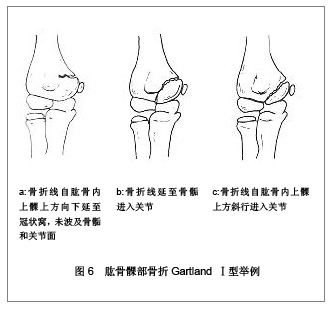

1.2 肱骨髁部骨折的力学特点[3] 1.2.1 载荷-应变关系 手臂上举屈伸运动时,肱骨受力载荷在400-800 N,提重物和支撑运动时的载荷大约在500 N,推拉运动时的载荷在300-650 N,当载荷在500 N以上时,会对肱骨产生局部的破坏。在测试肱骨髁部的载荷应变关系时,中间低,两侧高,呈凹字变化,髁部应变小于内外髁的应变。外侧髁的应变最大,分析原因是可能由于肱骨特殊的解剖学结构所致,肱骨提携角使外髁的受力最大。可见,肱骨髁部的应变呈线性变化,随着载荷的增加而增大,交叉克氏针内固定的应变值明显高于钢板内固定。 1.2.2 载荷-位移关系 肱骨髁部在外力的作用下会发生垂直位移和水平位移,而且位移呈线性变化,随着载荷的增加而增大。在应用钢板内固定时,垂直位移最小,显示钢板内固定后的牢固性更好,交叉克氏针内固定的垂直位移最大。在固定肱骨髁部骨折时,常会从外向内贯穿肱骨滑车打入松质骨螺钉,使髁间分离和内固定更加牢固,在髁部受力发生水平位移时,无论是交叉克氏针还是钢板内固定都可以减少水平位移。 1.2.3 刚度变化 刚度变化是指在外力的作用下,肱骨髁部产生单位变形,在相同外力的作用下,变形越小,表明材料的刚度越大。轴向刚度变化是衡量内固定治疗后骨折部位抗轴向变化能力的重要指标,由纵向压缩载荷和垂直位移所决定,轴向刚度计算公式如下:"

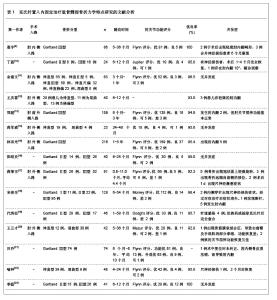
2 金属植入物内固定治疗肱骨髁部骨折的力学特点 2.1 交叉克氏针置入内固定治疗儿童肱骨髁上骨折力学特点的病例分析 交叉克氏针置入内固定治疗肱骨髁间骨折,操作方法简单,对尺神经损伤的机率较小,不必作神经前移。另外,交叉克氏针内固定有很强的轴向压缩力,使骨折端与肱骨的复位结合得更加紧密,骨不连的发生率减少,促进了骨折的愈合。因此,交叉克氏针置入内固定在肱骨髁间粉碎性骨折的治疗中应用较多,符合该部位的解剖结构和生物力学的要求。 儿童肱骨髁上Gartland Ⅲ型骨折常合并旋转移位,使手法整复困难,且稳定性较差,容易影响肘关节功能,并易致内翻畸形,必要时需要选择手术治疗[4]。自2005年5月至2010年8月在大姚县人民医院创伤外科采用后侧切口交叉克氏针内固定,外用肘前“8”字绷带包绕固定的方法治疗儿童Gartland Ⅲ型肱骨髁上骨折32例,临床疗效满意,现将交叉克氏针置入内固定治疗儿童肱骨髁间骨折力学特点的病例分析报告如下。 2.1.1 病例资料 选取大姚县人民医院创伤外科Gartland分型为Ⅲ型的患者32例,其中,男23例,女9例,年龄范围在3-14岁,平均年龄在6.5岁。32例患者中,左侧骨折18例,右侧骨折14例。受伤至手术的时间为3-6 d,平均时间为4 d。20例为手法复位失败患者,12例患者入院时患处肿胀严重,无条件复位。合并正中神经不完全性损伤2例,桡神经不完全性损伤2例(含医源性损伤1例),不合并有肱动脉及尺神经损伤。 2.1.2 治疗方法 采用静脉复合麻醉或基础加臂丛神经阻滞麻醉。患儿仰卧,患肢置于胸前由助手站在对侧提拉,驱血后上止血带,术前30-60 min常规预防性给单次剂量抗生素。以尺骨鹰嘴为标志,作起自尺骨鹰嘴延后正中直线向上的纵切口6-8 cm,切开皮肤及皮下组织并适当向两侧游离牵开,于尺神经沟解剖出尺神经并加以保护,纵形切开肱三头肌直达鹰嘴窝及肱骨上端后方骨质,稍作剥离显露骨折部后方及两侧面,清理骨折端之间的破碎组织,牵引提拉推压先纠正侧方及旋转移位,再纠正重叠移位,并注意保持30°-50°的髁干角,直视下解剖复位,并维持对位。摸清内外上髁并用克氏针刺探确定内外上髁最高点为进针点,分别用2枚1.5-2.0 mm的克氏针从内外上髁最高点与肱骨干纵轴呈45°-60°角钻入对侧近折端,并穿出骨皮质,2克氏针交叉点应在近折端骨质内,避免在骨折部位交叉减弱固定针的抗旋转力。直视下观察骨折解剖复位,髁干角正常,被动活动肘关节不受限,肘关节活动时骨折处无移位。退针约0.8 cm,将两针尾折弯剪短后推入原针道埋于皮下固定,并保证针尖穿出近折端对侧骨皮质2.0-3.0 mm。压迫切口放松止血带,约10 min后冲洗创口,分层缝合切开的各层组织,切口内置橡皮片引流,包封切口。 2.1.3 术后处理 术后肘关节屈曲在80°-90°位置,用肘前“8”字绷带包绕固定,术后24-48 h内拔出橡皮引流片,次日开始进行手指及腕肩关节的主动锻炼,并应用抗生素3-5 d,必要时还需要应用消肿止痛药物,术后2周解除肘前“8”字绷带,开始加强肘关节的屈伸活动锻炼,二三个月在局麻的条件下拔除克氏针。 2.1.4 治疗结果 32例患者获得随访,随访时间10-28个月,平均随访时间14个月。4-7周骨折全部愈合。术前合并有正中神经及尺神经不完全性损伤的4例患者于术后3-6个月内完全恢复。克氏针尾部自行退出皮外2例,未发生切口及针孔感染。术中未发生肱动脉及神经损伤,术后未发生Volkmann缺血性肌挛缩,骨化性肌炎及肘内外翻畸形。按Flynn评定的标准,把提携角和功能丧失度同健侧进行对比,优0°-5°,良6°-10°,可11°-15°,差大于15°,肘关节疗效评定结果,优19例,良11例,可2例,优良率93.75%。 2.1.5 治疗体会 对有明显移位的儿童肱骨髁上骨折绝大部分仍以手法复位石膏托外固定及闭合复位闭合穿针内固定加石膏托外固定的方法治疗为主。不主张多次手法复位或/和反复闭合穿针固定,这不仅增加患儿的痛苦,更增加局部软组织的损伤,增加骨化性肌炎及医源性神经、血管损伤发生的概率,增加肘关节功能障碍发生的风险。手术最简单有效经济的固定方法就是克氏针内固定。 目前切开复位内固定的手术入路主要有:①肘外侧入路。②肘内侧入路。③肘前方入路。④肘内外侧联合入路。⑤改良外侧入路[5]。⑥肘后入路。关于手术入路现诸多学者仍存在争议。经肘内、外侧单一入路只显露一侧皮质,在有限显露的情况下难以确定远折端对侧面是否存在旋转,分离或嵌插,髁干角是否己恢复不易掌握,无论从内或外上髁用2枚克氏针固定未达到双柱固定作用,其力学稳定性都不如分别自内外上髁穿针交叉固定稳定。肘内外侧联合入路显露虽较单一内或外侧入路充分,具备了肘内或外侧入路的优点,利于骨折复位及固定,但增加了手术切口,延长了手术时间,部分患者不愿接受。肘前入路因解剖结构复杂,显露不充分,同时需避开肱动静脉及正中神经,除合并有肱动静脉及正中神经损伤,不宜常规采用。改良外侧入路尚缺乏临床经验,值得借鉴探讨。肘后肱三肌舌状瓣切开及“Z”字型切开入路对肱三头肌损伤相对较大。 对手法复位失败的儿童肱骨髁上Gartland Ⅲ型骨折均行后侧切口切开复位交叉克氏针内固定,采用肘后肱三头肌纵形剖开直达肱骨远端骨膜下入路几乎不切断肱三头肌,同时可充分显露保护尺神经,最大限度的避免了术中损伤尺神经的可能性,在良好的肌松及肘关节半伸直位时,向两侧行骨膜下剥离牵开,能较好地显露肱骨髁上骨折部后方及两侧面,同时显露鹰嘴窝,进针点容易定位,为直视下解剖复位及克氏针准确进针及稳定固定提供了良好的显露,术中甚至可以观察到克氏针自远折端穿出进入近折端的位置及方向,触摸或观察到克氏针的头端穿出近折端对侧骨皮质的位置及长度,保证2枚克氏针达到理想的固定位置及最佳固定效果,避免克氏针误入前方造成血管神经损伤及反复多次穿针,导致克氏针针道扩大,在功能锻炼过程中发生退针,固定失效。理想的进针位置及稳定的固定为术后只需肘前“8”字绷带包绕固定及早期功能锻炼提供了良好条件。文中入路因显露良好,术中在直视下解剖复位,基本不需行“C”型臂透视或术中摄片检查及调整,明显缩短了手术时间,减少或避免医护人员及患儿受X射线照射的机会,减少手术创伤和手术并发症,为术后功能恢复奠定了基础。 肘内翻畸形是肱骨髁上骨折晚期最常见并发症,发生率高达30%-60%[6]。各种类型骨折都有可能发生肘内翻畸形,术中复位不全遗留尺偏矫正不完全,内侧嵌插,以及旋转移位,是远期容易并发肘内翻的重要原因[7]。本文入路具有操作相对简单,显露充分,便于复位及准确穿针固定,手术并发症少,无肘内外翻畸形及医源性神经、血管损伤等并发症的发生,术后功能恢复良好,值得临床推广应用。但因本文病例尚少,随访时间有限,肱骨远端骨骺闭合前仍有可能发生肘内外翻畸形,远期疗效尚待进一步观察。 2.2 金属植入物内固定治疗肱骨髁部骨折力学特点的文献分析 2.2.1 资料来源 检索数据库有关金属植入物内固定治疗肱骨髁部骨折力学特点研究的文献[8],检索时间范围在2010至2012年,检索词为“内固定;肱骨髁部骨折;肱骨髁上骨折;肱骨髁间骨折;肱骨髁外骨折;力学分析”,检索到相关文献1 044篇,结果分析相关文献22篇[9-30]。 2.2.2 纳入标准 与金属植入物内固定治疗肱骨髁部骨折力学特点研究相关的文献。 2.2.3 排除标准 重复研究、普通综述或Meta分析类文章。 2.2.4 分析指标 ①克氏针置入内固定治疗肱骨髁部骨折力学特点研究的文献分析。②不同金属植入物内固定治疗肱骨髁部骨折力学特点研究的文献分析。 2.2.5 克氏针置入内固定治疗肱骨髁部骨折力学特点研究的文献分析 相关文献分析,见表1。 2.2.6 不同金属植入物内固定治疗肱骨髁部骨折力学特点研究的文献分析 相关文献分析,见表2。 2.2.7 不同手术入路内固定治疗肱骨髁部骨折力学特点研究的文献分析 相关文献分析,见表3。 2.2.8 不同克氏针内固定治疗肱骨髁部骨折力学特点研究的文献分析 吴向科等[29]比较不同克氏针内固定方法治疗Gartland Ⅲ型儿童肱骨髁上骨折的临床疗效,内外侧交叉克氏针固定治疗24例,外侧双皮质克氏针固定治疗21例。术后肘关节功能评定,应用内外侧交叉克氏针治疗后优12例,良9例,差3例,优良率为87.5%,外侧双皮质克氏针治疗后优10例,良6例,差5例,优良率为76.1%。结果显示内外侧交叉固定与外侧双皮质固定具有稳定性高,关节功能恢复快,临床疗效好的特点。 2.2.9 克氏针不同固定方式治疗肱骨髁部骨折力学特点研究的文献分析 吕召民等[30]探讨儿童Gartland Ⅲ型肱骨髁上骨折的最佳手术治疗方案,搜集3年内6-12岁肱骨髁上骨折患儿38例,随机分内外交叉克氏针内固定组20例和外侧平行克氏针内固定组18例。治疗后均达到解剖复位,随访时间12-18个月,平均16个月,根据Flynn标准评定,内外交叉克氏针内固定组关节功能优良率为90%,外侧平行克氏针内固定组为94.4%,差异无显著性意义 (P > 0.05)。有4例出现肘内翻畸形,1例出现尺神经损伤。显示儿童Gartland Ⅲ型肱骨髁上骨折两种克氏针固定方式效果相似,均能达到满意的效果,但外侧平行克氏针内固定可以避免医源性尺神经损伤。"
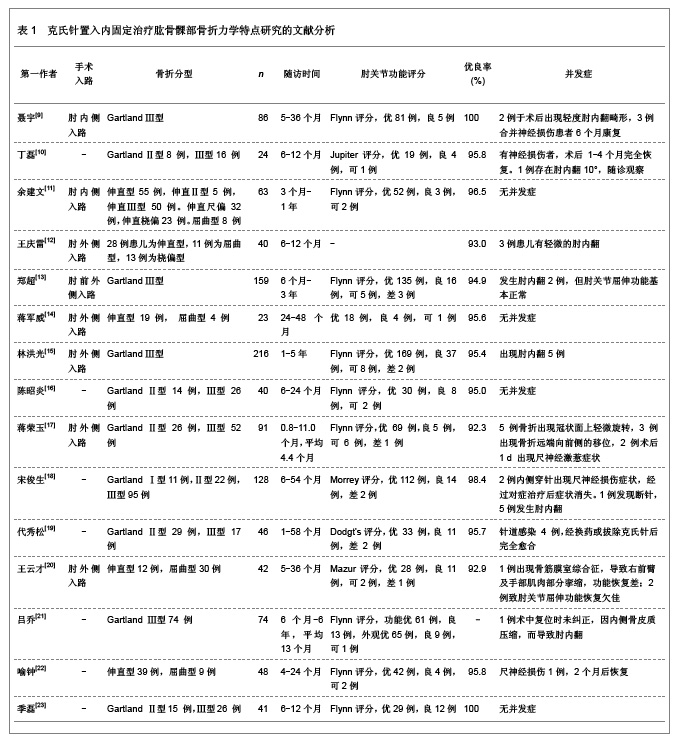
| [1] 王序全. 重视肱骨远端骨折的诊治[J].中国骨伤,2009,22(5): 327-329.[2] 好医生.肱骨髁间骨折[DB/OL].2012-12-10.http://medicaldb. haoyisheng.com[3] 张磊.肱骨髁间骨折内固定方法的生物力学比较及三维有限元分析[D].广东:第一军医大学,2005:11-14.[4] 杨建平.儿童肱骨髁上骨折的现代处理[J].中华骨科杂志,2009, 11(4):302-305.[5] 胡飞,尚希福,赵其纯,等.改良外侧入路切开复位治疗儿童肱骨髁上骨折的前瞻性研究[J].中华创伤骨科杂志,2009,11(5): 408-411.[6] 梁军,钱洁,李明,等.肱骨髁上骨折的并发症及防冶[J].骨与关节损伤杂志,2001,16(6):459.[7] 朱红,唐付林,蒲超,等.肘内侧入路治疗儿童重度旋转肱骨髁上骨折的初步疗效分析[J].中国骨与关节损伤杂志,2011,26(1):88.[8] 中国知网.中国学术期刊总库[DB/OL].2012-12-10. https://www.cnki.net[9] 聂宇.内侧入路克氏针内固定治疗儿童肱骨髁上骨折[J].临床骨科杂志,2011,14(2):147-149.[10] 丁磊,严松鹤.手法复位经皮克氏针内固定治疗小儿肱骨髁上骨折24例[J].实用中医药杂志,2012,28(11):950-951.[11] 余建文,刁天月,李健华,等.肘关节内侧切口交叉克氏针内固定治疗儿童肱骨髁上骨折[J].实用骨科杂志,2012,18(10):923-924.[12] 王庆雷.外侧小切口克氏针张力带内固定治疗儿童肱骨髁上骨折的临床分析[J].中国医药指南,2012,10(29):452-453.[13] 郑超,李明.肘前外侧入路切开复位治疗儿童严重型肱骨髁上骨折159例[J].重庆医学,2012,41(26):2733-2735,2737.[14] 蒋军威.可吸收线配合克氏针治疗儿童肱骨髁上骨折[J].吉林医学,2012,33(25):5499-5500.[15] 林洪光,刘爱刚,郑文忠,等.肘部外侧入路治疗儿童Ⅲ型肱骨髁上骨折[J].实用骨科杂志,2012,18(8):731-734.[16] 陈昭炎.闭合复位经皮交叉克氏针内固定治疗小儿肱骨髁上骨折的疗效[J].实用临床医学(江西),2012,13(8):61-62.[17] 蒋荣玉,吴东敏,莫贤跃,等.闭合复位经皮克氏针内固定治疗儿童肱骨髁上骨折[J].中国卫生产业,2012,9(21):128.[18] 宋俊生.经皮克氏针固定治疗儿童肱骨髁上骨折128例疗效分析[J].实用骨科杂志,2012,18(5):457-459.[19] 代秀松,肖玉周,官建中,等.闭合复位交叉克氏针固定治疗儿童肱骨髁上骨折 46 例分析[J].蚌埠医学院学报,2012,37(7): 778-780.[20] 王云才,戴文达.克氏针交叉内固定治疗肱骨髁上骨折的疗效分析[J].中国临床医学,2012,19(3):268-269.[21] 吕乔,刘卫华,阮安培.闭合复位经皮克氏针固定治疗Gartland Ⅲ型儿童肱骨髁上骨折[J].中国医药导报,2012,9(7):157-158,160.[22] 喻钟.闭合复位经皮克氏针内固定治疗儿童肱骨髁上骨折临床疗效分析[J].中国医药指南,2012,10(9):167-168.[23] 季磊.闭合复位经皮克氏针内固定治疗儿童肱骨髁上骨折41例临床分析[J].中国煤炭工业医学杂志,2012,15(2):220-221.[24] 谢志新,吴迪,虢新莲,等. Y形钢板和双钢板经不同置入途径治疗肱骨髁间骨折的比较[J].中国组织工程研究与临床康复,2011,15(17):3103-3108.[25] 麦胡强,徐孟凡.肱骨髁间粉碎性骨折的不同内固定方法治疗比较[J].安徽医学,2011,32(7):969-970.[26] 向启利,徐永清,杨怀芬,等.儿童肱骨髁上骨折不同手术入路的比较分析[J].临床骨科杂志,2012,15(4):407-408.[27] 林志炯,苏培基,伍中庆,等.不同入路手术治疗肱骨髁间骨折的疗效比较[J].中国中西医结合外科杂志,2009,15(2):161-162.[28] 沈爱东,杨惠光,张云庆,等.两种不同手术入路治疗小儿肱骨髁上骨折的比较[J].临床骨科杂志,2009,12(4):428-430.[29] 吴向科,谢伟.不同克氏针内固定方法治疗Gartland Ⅲ型儿童肱骨髁上骨折临床疗效比较[J].浙江中医药大学学报,2010,34(2): 197-198.[30] 吕召民,段华章.克氏针不同固定方式治疗儿童Gartland Ⅲ型肱骨髁上骨折的疗效比较[J].中国中医骨伤科杂志,2012,20(3): 28-30. |
| [1] | Xu Feng, Kang Hui, Wei Tanjun, Xi Jintao. Biomechanical analysis of different fixation methods of pedicle screws for thoracolumbar fracture [J]. Chinese Journal of Tissue Engineering Research, 2021, 25(9): 1313-1317. |
| [2] | Chen Xinmin, Li Wenbiao, Xiong Kaikai, Xiong Xiaoyan, Zheng Liqin, Li Musheng, Zheng Yongze, Lin Ziling. Type A3.3 femoral intertrochanteric fracture with augmented proximal femoral nail anti-rotation in the elderly: finite element analysis of the optimal amount of bone cement [J]. Chinese Journal of Tissue Engineering Research, 2021, 25(9): 1404-1409. |
| [3] | Zhou Jihui, Li Xinzhi, Zhou You, Huang Wei, Chen Wenyao. Multiple problems in the selection of implants for patellar fracture [J]. Chinese Journal of Tissue Engineering Research, 2021, 25(9): 1440-1445. |
| [4] | Luo Lin, Song Naiqing, Huang Jin, Zou Xiaodong. Review and prospect of international research on preschool children’s movement development assessment: a CiteSpace-based visual analysis [J]. Chinese Journal of Tissue Engineering Research, 2021, 25(8): 1270-1276. |
| [5] | Xu Yulin, Shen Shi, Zhuo Naiqiang, Yang Huilin, Yang Chao, Li Yang, Zhao Heng, Zhao Lu. Biomechanical comparison of three different plate fixation methods for acetabular posterior column fractures in standing and sitting positions [J]. Chinese Journal of Tissue Engineering Research, 2021, 25(6): 826-830. |
| [6] | Cai Qunbin, Zou Xia, Hu Jiantao, Chen Xinmin, Zheng Liqin, Huang Peizhen, Lin Ziling, Jiang Ziwei. Relationship between tip-apex distance and stability of intertrochanteric femoral fractures with proximal femoral anti-rotation nail: a finite element analysis [J]. Chinese Journal of Tissue Engineering Research, 2021, 25(6): 831-836. |
| [7] | Song Chengjie, Chang Hengrui, Shi Mingxin, Meng Xianzhong. Research progress in biomechanical stability of lateral lumbar interbody fusion [J]. Chinese Journal of Tissue Engineering Research, 2021, 25(6): 923-928. |
| [8] | Kong Lingbao, Lü Xin. Effect of implant selection and approach on support in the operation of posterolateral tibial plateau fractures [J]. Chinese Journal of Tissue Engineering Research, 2021, 25(6): 942-947. |
| [9] | Xie Chongxin, Zhang Lei. Comparison of knee degeneration after anterior cruciate ligament reconstruction with or without remnant preservation [J]. Chinese Journal of Tissue Engineering Research, 2021, 25(5): 735-740. |
| [10] | Zhou Jihui, Li Xinzhi, Zhou You, Huang Wei, Chen Wenyao. Comparison of the advantages and disadvantages of multiple implants in treatment of traumatic dislocation of sternoclavicular joint [J]. Chinese Journal of Tissue Engineering Research, 2021, 25(3): 443-448. |
| [11] | Nie Shaobo, Li Jiantao, Sun Jien, Zhao Zhe, Zhao Yanpeng, Zhang Licheng, Tang Peifu. Mechanical stability of medial support nail in treatment of severe osteoporotic intertrochanteric fracture [J]. Chinese Journal of Tissue Engineering Research, 2021, 25(3): 329-333. |
| [12] | Tan Jiachang, Yuan Zhenchao, Wu Zhenjie, Liu Bin, Zhao Jinmin. Biomechanical analysis of elastic nail combined with end caps and wire fixation for long oblique femoral shaft fractures [J]. Chinese Journal of Tissue Engineering Research, 2021, 25(3): 334-338. |
| [13] | Chen Lu, Zhang Jianguang, Deng Changgong, Yan Caiping, Zhang Wei, Zhang Yuan. Finite element analysis of locking screw assisted acetabular cup fixation [J]. Chinese Journal of Tissue Engineering Research, 2021, 25(3): 356-361. |
| [14] | Liu Yulin, Li Guotai. Combined effects of hyperbaric oxygen, vibration training and astaxanthin on bone mineral density, glucose metabolism and oxidative stress in diabetic osteoporosis rats [J]. Chinese Journal of Tissue Engineering Research, 2021, 25(20): 3117-3124. |
| [15] | Li Yuanyuan, Lu Yingjuan, Ye Yushan, Mustafa M.M Weldali, Chang Shaohai. Constructing finite element models of three maxillary arch forms [J]. Chinese Journal of Tissue Engineering Research, 2021, 25(20): 3125-3129. |
| Viewed | ||||||
|
Full text |
|
|||||
|
Abstract |
|
|||||
